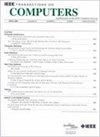重新思考空间架构中的控制流:控制流平面设计的见解
IF 3.6
2区 计算机科学
Q2 COMPUTER SCIENCE, HARDWARE & ARCHITECTURE
引用次数: 0
摘要
空间架构是一种高性能的范式,它采用控制流图和数据流图作为计算模型,生产者/消费者模型作为执行模型。然而,现有的空间架构与控制流处理的挑战作斗争。在彻底描述了它们的PE执行模型后,我们观察到它们缺乏自治的、点对点的、暂时松耦合的控制流处理能力。这降低了它在密集控制程序中的性能。为解决现有控制流处理难题,提出了一种具有显式设计控制流平面的空间结构“木偶”。我们精心开发了一个完整的木偶架构,从ISA,编译器,模拟器到RTL。木偶灵活的控制流平面支持自主的、点对点的、暂时松耦合的控制流管理。主动PE配置,保证计算重叠,及时配置,提升分支发散处理能力。此外,木偶的敏捷PE分配提高了不完美循环的管道性能。与最先进的空间架构相比,实验结果表明,在各种具有挑战性的密集控制程序中,Marionette优于Softbrain, TIA, REVEL和RipTide的几何值为2.88$\mathbf{\times}$, 3.38$\mathbf{\times}$, 1.55$\mathbf{\times}$和2.66$\mathbf{\times}$。本文章由计算机程序翻译,如有差异,请以英文原文为准。
Rethinking Control Flow in Spatial Architectures: Insights Into Control Flow Plane Design
Spatial architecture is a high-performance paradigm that employs control flow graphs and data flow graphs as computation model, and producer/consumer models as execution model. However, existing spatial architectures struggle with control flow handling challenges. Upon thoroughly characterizing their PE execution models, we observe that they lack autonomous, peer-to-peer, and temporally loosely-coupled control flow handling capability. This degrades its performance in intensive control programs. To tackle the existing control flow handling challenges, Marionette, a spatial architecture with an explicit-designed control flow plane, is proposed. We elaborately develop a full stack of Marionette architecture, from ISA, compiler, simulator to RTL. Marionette's flexible Control Flow Plane enables autonomous, peer-to-peer, and temporally loosely-coupled control flow management. Its Proactive PE Configuration ensures computation-overlapped and timely configuration to promote Branch Divergence handling capability. Besides, Marionette's Agile PE Assignment improves pipeline performance of imperfect loops. Compared to state-of-the-art spatial architectures, the experimental results demonstrate that Marionette outperforms Softbrain, TIA, REVEL, and RipTide by geomean 2.88
$\mathbf{\times}$ $\mathbf{\times}$ $\mathbf{\times}$ $\mathbf{\times}$
求助全文
通过发布文献求助,成功后即可免费获取论文全文。
去求助
来源期刊

IEEE Transactions on Computers
工程技术-工程:电子与电气
CiteScore
6.60
自引率
5.40%
发文量
199
审稿时长
6.0 months
期刊介绍:
The IEEE Transactions on Computers is a monthly publication with a wide distribution to researchers, developers, technical managers, and educators in the computer field. It publishes papers on research in areas of current interest to the readers. These areas include, but are not limited to, the following: a) computer organizations and architectures; b) operating systems, software systems, and communication protocols; c) real-time systems and embedded systems; d) digital devices, computer components, and interconnection networks; e) specification, design, prototyping, and testing methods and tools; f) performance, fault tolerance, reliability, security, and testability; g) case studies and experimental and theoretical evaluations; and h) new and important applications and trends.
 求助内容:
求助内容: 应助结果提醒方式:
应助结果提醒方式:


